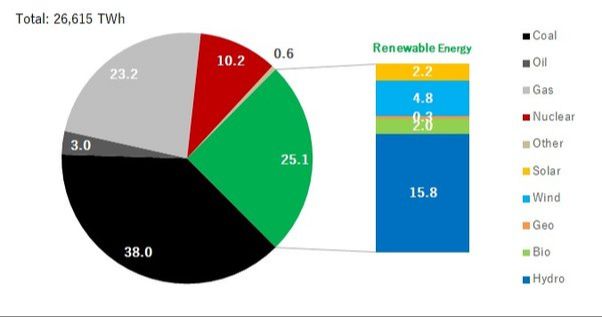What Percentage Of Electricity Comes From Fossil Fuels?

Electricity powers our modern world. From lighting our homes to powering our appliances and devices, access to electricity is something many take for granted. However, producing all this electricity comes at an environmental cost. Much of our electricity still comes from burning fossil fuels like coal and natural gas. But with growing concern about climate change and air pollution, there has been an increasing focus on transitioning to renewable sources of electricity like solar and wind. This raises an important question – what percentage of our electricity still comes from fossil fuels today?
What are fossil fuels?
Fossil fuels are energy resources formed over millions of years from the remains of living organisms buried underground and exposed to heat and pressure. The three main types of fossil fuels are coal, natural gas, and petroleum (oil).
Coal started forming during the Carboniferous period around 359–299 million years ago from dead plant matter like trees, ferns, and algae that settled in swamps. Over time, layers of mud and soil buried the plant matter and without oxygen, it could not decompose. The weight and pressure turned the carbon in the dead plants into peat and then into coal.
Natural gas and oil also come from marine organisms like algae and zooplankton that lived millions of years ago. When they died, they sank to the bottom of the oceans where they were covered in layers of sediment over time. Heat and pressure from these sediment layers turned the organic material into crude oil and natural gas which can be extracted today.[1]
Fossil fuels in electricity generation
Historically, most electricity in the United States has come from burning fossil fuels like coal, natural gas, and oil. According to the U.S. Energy Information Administration (EIA), fossil fuels accounted for about 81% of total U.S. primary energy production in 2022.
Coal has been the biggest source of electricity in the U.S. for decades. In 2020, coal fueled about 19% of U.S. electricity generation. However, coal’s share has declined as natural gas and renewables have grown. Natural gas accounted for about 38% of U.S. electricity generation in 2020. The share of oil for electricity generation was only about 1% in 2020.
The EIA reports that the total fossil fuel share of energy consumption has decreased in recent years as renewable energy and nuclear power have grown. But fossil fuels still make up the majority of U.S. electricity generation.
Growth of renewables
In recent years, renewable energy sources like solar, wind, and hydro have become increasingly cost competitive with fossil fuels for electricity generation. This is largely due to rapid technological improvements and manufacturing scale, which have dramatically reduced costs. According to one analysis, the cost of solar PV electricity fell 88% between 2009 and 2019.[1]
Many governments have also implemented policies and incentives to encourage renewable energy growth, such as tax credits, rebates, renewable portfolio standards, and feed-in tariffs. These measures have helped drive deployment of renewables across the globe. The International Renewable Energy Agency (IRENA) estimates that government incentives for renewables totaled at least $166 billion globally in 2017.[2]
As a result of these trends, renewables like wind and solar accounted for over 50% of new power generation capacity added globally in 2019.[3] Renewables are growing rapidly and taking an increasing share of electricity generation worldwide.
Current percentage from fossil fuels
According to the U.S. Energy Information Administration (EIA), about 60% of electricity generation in the United States came from fossil fuels in 2020 [1]. This includes coal, natural gas, petroleum, and other gases. The percentage varies significantly by country. In Canada, fossil fuels accounted for around 66% of electricity generation in 2019 [2]. The UK generated around 40% of its electricity from fossil fuels in 2020 [3]. And in France, only 7% came from fossil fuels due to its heavy reliance on nuclear power [4].
So while the global average is around 60%, national percentages vary widely based on the energy mix and availability of renewable sources.
Projections for the future
Reports from the International Energy Agency (IEA) project a significant decline in electricity from fossil fuels in the coming decades. According to the IEA’s World Energy Outlook 2022, the share of fossil fuels in electricity generation could fall to just over 50% by 2030 based on current policies, down from around 60% today.
Many governments have set ambitious goals to reduce fossil fuel reliance and increase renewable energy. For example, the European Union aims to source 32% of its energy from renewables by 2030. The United States plans to decarbonize its power sector by 2035. China aims to reach peak carbon emissions before 2030.
Modeling by the U.S. Energy Information Administration projects the share of fossil fuels in global electricity dropping to between 31-51% by 2050, depending on policy choices. This represents a major shift away from a centuries-old reliance on coal, oil, and natural gas.
Challenges reducing fossil fuel reliance
There are several key challenges to reducing reliance on fossil fuels for electricity generation. One major challenge is the existing energy infrastructure that has been built around fossil fuel power plants. Most power plants, transmission lines, and distribution systems were designed specifically for coal, natural gas, or oil [1]. Transitioning to renewable sources like wind and solar requires new investments in infrastructure adapted to harness these intermittent resources. There is inertia and sunk costs that make it difficult to move away from the status quo.
Another major challenge is resistance from the fossil fuel industry. Coal, oil, and natural gas companies have historically had large profits tied to traditional power plants [2]. These companies lobby policymakers against regulations, subsidies, or programs that support renewables over fossil fuels. They also downplay the negative impacts of fossil fuels. Overcoming this resistance requires policies that account for the transition costs and economic impacts on fossil fuel-dependent communities.
Benefits of transitioning away from fossil fuels
Transitioning electricity generation away from fossil fuels provides important benefits for public health, the environment, and energy security. According to a study by Ortiz et al. (2023), shifting to zero-emission renewable electricity would help reduce three major externalities of fossil fuel use: air pollution, GHG emissions, and water contamination. Some key benefits of this transition include:
Reduced air pollution: Burning fossil fuels for electricity emits pollutants like particulate matter, sulfur dioxide, and nitrogen oxides, which contribute to 3.6 million premature deaths annually. Transitioning to clean renewable energy would significantly reduce emissions of these dangerous pollutants, improving respiratory health.
Mitigating climate change: The power sector accounts for 42% of energy-related carbon dioxide emissions. Phasing out fossil fuels for electricity and replacing them with renewable sources like solar, wind, and hydropower is critical for limiting global temperature rise to 1.5°C and avoiding catastrophic climate impacts.
Energy independence: Relying on domestic renewable resources reduces a nation’s vulnerability to fuel price shocks and instability in international energy markets. Local renewables lead to greater energy security and independence.
How readers can make a difference
There are two main ways that everyday citizens can help reduce reliance on fossil fuels:
Supporting renewable energy policies
One impactful action is to support policies and politicians that aim to accelerate the transition to renewable energy. This includes voting for candidates and referendums that promote investment in renewable infrastructure, clean energy subsidies, carbon pricing mechanisms, and other fossil fuel reduction policies. Citizens can also join advocacy organizations that lobby for these causes.
According to a 2021 report by the International Renewable Energy Agency (IRENA), while costs for renewables have fallen dramatically, fossil fuel subsidies remain high, slowing the transition. Public policies that end fossil fuel subsidies and incentivize renewables will be key.
Making personal energy use choices
Individuals can also reduce fossil fuel dependence through their personal choices. Options include switching to a clean energy provider, investing in rooftop solar, purchasing an electric vehicle, improving home energy efficiency, and reducing overall energy usage. Even simple steps like turning off lights, adjusting thermostats, and line-drying clothes can make an incremental difference.
Additionally, citizens can use their buying power to choose businesses committed to renewable energy and reducing emissions. Patronizing car-free establishments and locally sourced products are other impactful steps.
Conclusion
In summary, currently 68% of the world’s electricity comes from fossil fuels like coal, natural gas, and oil. However, renewable energy sources like solar, wind, and hydropower are growing rapidly as costs fall and countries seek to reduce emissions and achieve energy independence. While fossil fuels still dominate, global renewable electricity capacity could grow 45% from 2020 levels by 2026. The transition to clean energy brings many benefits like economic growth, jobs, and improved public health, but also faces challenges around technology, infrastructure, and stranded assets. Everyone has a role to play through energy conservation, advocacy, and choosing clean power.
To build a sustainable future, we must accelerate the transition away from polluting fossil fuels and towards renewables through policies, investment, and changing how we produce and consume energy. The decisions we make today will shape the planet for generations to come.





